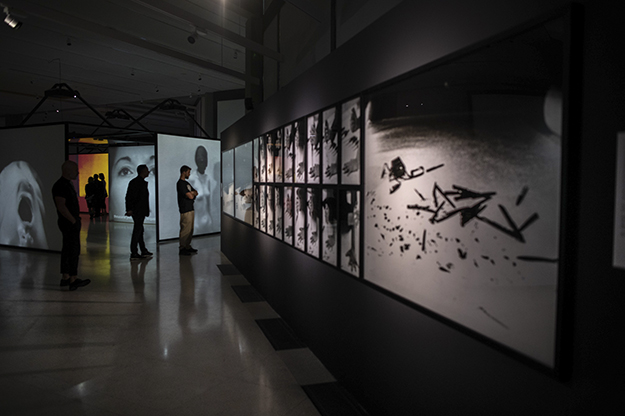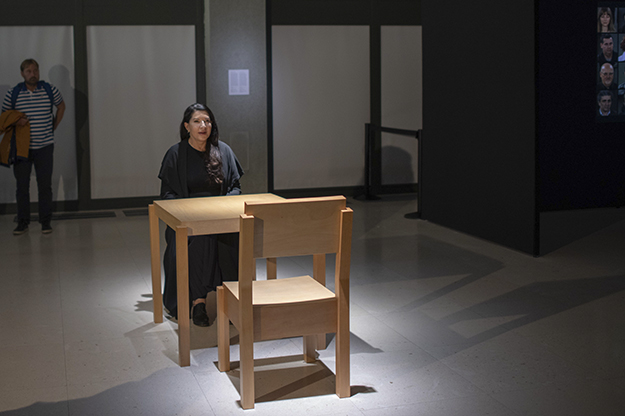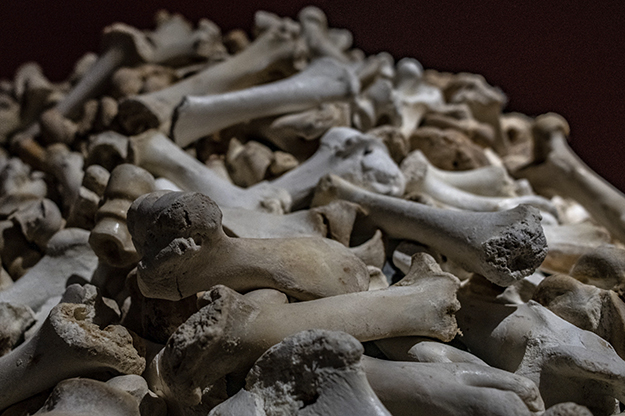On September 21, World Cleanup Day, Belgrade’s Museum of Contemporary Art (MSU) opened “The Cleaner,” a large retrospective exhibition of works by Marina Abramović.
“I did not plan on this,” the artist revealed to journalists after reading an excerpt from a local newspaper with a smile of genuine bewilderment.
It has been more than four decades since Abramović packed her bags and flew to Amsterdam. Back then, in 1976, she was still some artist from Yugoslavia relatively unknown to the world, working as part of a small, alternative art scene based in Belgrade’s Student Cultural Centre.
Before that, she had received her education in Belgrade and Zagreb (where she had studied to be a painter), and she subsequently made her international debut at the “Contemporara” exhibition held in Rome; here, she performed a dangerous play involving knives titled “Rhythm 10.” A year later, during one early performance in the Yugoslav capital, she almost got herself killed.
“To us, a tight circle of people witnessing it, Marina’s early works promised that something big would happen in the next four decades or so.”
Jerko Denegri, art historian
“Perhaps it will seem uncanny, but to us, a tight circle of people witnessing it, Marina’s early works promised that something big would happen in the next four decades or so,” says Jerko Denegri, the author of the first published media piece on Marina Abramović, as well as an art historian and friend of hers.
Denegri believes that everything was clear immediately following the 1973 “Rhythm 10” performance in Rome: The artist modified a Russian game with 20 knives whereby she would take one of them and swiftly plunge it into the empty spaces between her outstretched fingers back and forth, all the while recording sound. Every time she cut herself, she would pull out a new knife. When she ran out of knives, she would start from the beginning, synchronizing herself with the recording in order to show how the past and present overlap.
However, this was not the most radical episode in her early career.
At “The Cleaner,” visitors have an opportunity to take a look at the previously unpublished photographs from “Rhythm 5,” a 1974 performance in which Abramović poured 100 liters of petrol onto a five-pointed star made of sawdust and set it on fire in the Student Cultural Centre courtyard.
“That was a very emotional performance,” says Denegri, who was present that evening.
“She cut her hair and nails and tossed them into the fire; this was an act that we could not fully comprehend since we had no instruments to do so, we did not have reading instruments that we have today,” he recalls.
“Some would say that when a woman lets go of her hair and toenails, she symbolically renounces motherhood. I am not sure whether she thought about it back then, but as an art historian, I have no doubts as to what that act may have meant,” Denegri explains.

“The Cleaner” will be on display in the Museum of Contemporary Art in Belgrade until January 20, 2020. Photo: Courtesy of Gilad Sade.
In 2016, the artist would face a widespread backlash after giving an interview to the German magazine Spiegel, where she revealed that she had gotten three abortions and that she did not regret a single one of them.
Having cut her hair and nails, Abramović laid herself down within the burning star.
“At that moment, I did not get through my head that there would be no oxygen down there, and I later realized that I had lost consciousness as soon as my leg was caught in the flames,” she later explained.
To this day, there is debate over who leapt into the fire to save her.
Cleaning up the culture budget
No sooner had the Museum of Contemporary Art closed in mid-July, due to the preparations for “The Cleaner,” did posters and billboards begin to pop up across the entire city. They are currently so numerous that the replica of Marina Abramović’s famous stare can be seen at virtually every other bus stop in Belgrade.
Concurrently with discussion on the process of advertising, a debate was sparked off as to whether Marina Abramović serves the regime of Serbian President Aleksandar Vučić.
The Serbian government has supported the exhibition with approximately half a million euros, which is roughly equivalent to the Museum’s annual budget. Furthermore, Marina Abramović was invited to Serbia personally by Prime Minister Ana Brnabić.
“We met at this event [last year] and Ana Brnabić asked me how come I hadn’t been to Belgrade since I left,” said Abramović at a press conference ahead of the opening.
After telling Brnabić that she had never been invited, Serbia’s prime minister promised that she would be the one to send out the invitation. “So she did, and I am very grateful to her for what she has done,” the artist said.

“The Artist is Present” premiered in MoMa, New York, in 2010. Photo: Jovana Georgievski / K2.0.
MSU points out that the most important thing regarding this particular exhibition is the fact that “an international, yet our very own” artist has arrived in Belgrade.
“I do not see how Marina Abramović is used by anyone for pushing their political propaganda,” Dejan Sretenović, the museum’s curator and one of the exhibition’s co-curators, explained to K2.0 at the opening event.
According to Sretenović, Belgrade would not be able to hold such an event had it not been for the government itself that gave Abramović a guarantee that it would indeed take place.
The Museum of Contemporary Art hopes that in the coming four months — for the duration of the exhibition — they will be able to attract about 150,000 visitors.
“If the state is the museum’s major sponsor and if it funds it in every possible way, I do not find anything wrong with it offering support to an exhibition that exceeds regular budgets,” Sretenović concluded, before adding: “I think this should be an established practice, which would enable production standards to be raised.”
The Museum of Contemporary Art hopes that in the coming four months — for the duration of the exhibition — they will be able to attract about 150,000 visitors. Therefore, more people are expected to come than over the entire course of last year, in which the museum opened its doors after a 10-year-long hiatus.
Misery behind the scenes
It appears though that even a budget of more than half a million euros has not been enough for the exhibition to meet some basic standards when it comes to respecting the rights of workers, despite claims from organizers that the exhibition would be presented as it had been elsewhere around the world.
Amongst the people taking part at the exhibition are the so-called re-performers, who give some of the best-renowned performances by artist’s on a daily basis.
Since the exhibition had toured Stockholm, Humlebæk, Oslo, Bonn, Florence and Toronto before arriving in Belgrade, the Marina Abramović Institute hired a group of young artists and trained them for these performances.
But one of the people who partook in this exhibition internationally explains that the working conditions in Belgrade are much worse than elsewhere.
“Today, I was told that I would make only 25 euros at the opening, which is preposterous,” says one interviewee, who wanted to stay anonymous.
She adds that the Museum of Contemporary Art in Belgrade has set out such rules that the re-performers are paid only for the time they spend actually giving the performance.
“We have never found ourselves in a situation like that,” the interviewee says. “We perform for two hours with an hour break in between, and we are required to arrive an hour earlier so that we can prepare ourselves. The people from the museum told us that there is no way they would pay us for these breaks and preparations, so now we are trying to negotiate with them.”
“The museum has rented us a place where there are not enough beds for all of us, and therefore I am sharing my bed.”
One of the performers at 'The Cleaner'
She claims that just over half of the current performers come from abroad. Due to the exhibition, all of them have moved to Belgrade, where they will be staying for three months. Currently, they say, their living conditions are inadequate.
“The museum has rented us a place where there are not enough beds for all of us, and therefore I am sharing my bed,” explains the performer. “The door handles keep falling off, the storage water heater in my room is broken, and for some reason, the internet connection has been out for days, so I cannot even read my schedule for the next day, which I usually get in the evening by email.”
She stresses out that all re-performers love their job and their collective.
“Working for Marina Abramović is a great stepping stone in our careers and engagement in the collective led by her assistant is well organized,” she says.
But she adds that when it comes to finances, the Marina Abramović Institute — under whose umbrella these artists work — seems not to have been ready to fully back up their re-performers.
“When we make complaints to the Institute, we are told that we have signed a contract with the museum,” she says. “However, it is not us that talked terms with the museum, it is them, so we are a bit disappointed in that respect.”
She adds that some of the re-performers are considering leaving.
“We are all in the red and the money we earn cannot make for proper meals,” she says. “Considering that our labor is physical, we should not live on fast food, which is also the cheapest option, but it is exactly what is happening right now.”
The big unveil
Despite this situation, all is glittery on the main stage: The pre-premiere press conference was called at 6.23 a.m. (as Abramović explained, the aim was to “make journalists angry and get them into the state of performance”). Around 6,500 people were given tickets for an open air lecture that Abramović is set to deliver on September 28 (“No one has ever put on a lecture for that many people!” she told the journalists).
Tickets for the exhibition are still available, but they should be bought a few days in advance and reserved for the exact time slot. The MSU opens its doors every hour.
Apart from seeing some of her earliest paintings, visitors of the largest European retrospective of Abramović’s early works are invited to capture a moment when she gave up on painting and moved to conceptual art; the shift occurred at the 1971 “Drangularium” exhibition held in Belgrade’s Student Cultural Centre, where Abramović put on display a peanut shell and its shadow, naming her work “The Cloud and its Shadow.”
Tickets for the exhibition are still available, but they should be bought a few days in advance and reserved for the exact time slot.
Guests are able to see Marina crying while she was eating onions in 1995, while the following recording can be heard: “I’m tired from changing planes so often, waiting in the waiting rooms, bus stations…”; to watch a video of her painting a pentagram on her belly with her own blood (“Lips of Thomas”); to listen to the Yugoslav national anthem and look at the accompanying artefacts dating from the Second World War (“Hero,” the work inspired by the story of her father saving her wounded mother and taking her away on a white horse at the time when both of them fought in Partisan ranks).
Additionally, one can experience how it feels to take a seat across from an artist, as was the case in probably her most distinguished performance, “The Artist is Present.” In 2010, in the Museum of Modern Art in New York (MoMa), Abramović spent 512 hours sitting at the table, with people coming and going at the other side.
There is “Balkan Baroque” as well — a pile of exactly 1,000 cow bones, on which Abramović spent hours cleaning them of the last bits of meat and blood at the 1997 Venice Biennale. The bones smell of bone soup even to this day, causing visitors to jest about how she didn’t manage to clean them properly.
Jerko Denegri holds that what was crucial for this piece was the moment — the moment when the Balkans lost Marina Abramović, in a way, until she returned this year.

“Balkan Baroque” was presented at the 1997 Venice Biennale. Photo: Courtesy of Gilad Sade.
“At that point, she was chosen to represent Serbia and Montenegro, but certain milieus moved her out of the way nevertheless,” Denegri says. “The Biennale curator Germano Celant invited her to perform at the international pavilion. I think that by means of this work she wanted to make an additional statement on what the country could have had after she had been cold-shouldered. Perhaps the piece would have been completely different had she not been in this mood, had she not felt the need to express her pride.”
At the press conference, Abramović looked back at how her success had come late, how she had started everything more or less by herself, and that it had been anything but easy.
Non-professional members of the public vocally repeat that what she does is not art.
“If I had read everything they used to write about me, I would not have stepped out of my house at all.”
Marina Abramović
“If I had read everything they used to write about me, I would not have stepped out of my house at all,” she said. “Now versus then — I have been skimming through the papers lately — it has not changed that much.”
On the other hand, the fact is that one Yugoslav girl’s childhood ambition has been materialized and this fact can hardly be ignored today, particularly in billboard-teeming Belgrade.
This does not come as a surprise to Denegri:
“Here’s an anecdote for you. When she was still in her youth, Marina asked some critic from Belgrade whether she was beautiful enough to become a world class artist. He told her this: ‘Marina, you are beautiful and young, and you are already a world class artist, so in the next 40 years, you only need to prove it.’ That is the final result of this exhibition.”K
“The Cleaner” will be on display in the Museum of Contemporary Art in Belgrade until January 20, 2020.
Feature image: Courtesy of Gilad Sade.




